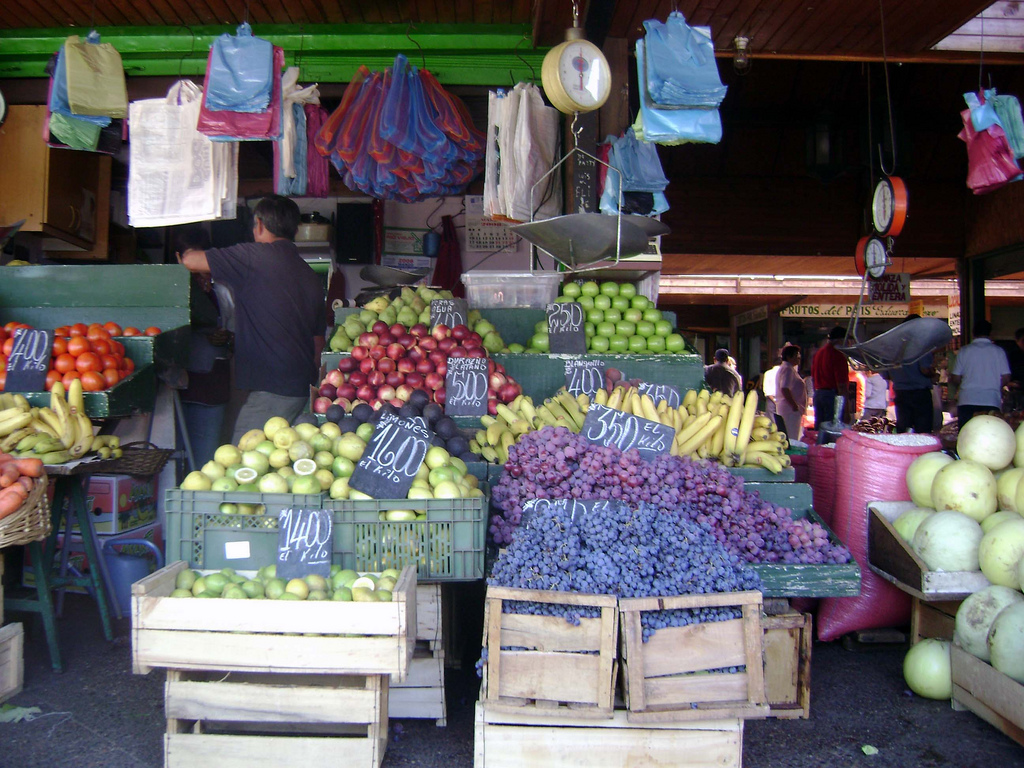
Fresh produce for sale at the Chillán Market. Photo © Consuelo Poblete, licensed Creative Commons Attribution.
Beset by natural disasters throughout its history, Chillán lacks even the limited colonial character of heartland cities such as Talca. But the birthplace of Chilean liberator Bernardo O’Higgins compensates with museums, its renowned Mexican murals—reason enough for stopping in the city—and the country’s most vibrant fruit-and-vegetable market. In addition to O’Higgins, Chillán has honored internationally known concert pianist Claudio Arrau with his own museum.Initially established as a Spanish fortress in 1565, Chillán dates officially from 1580, when Chilean governor Martín Ruiz de Gamboa decreed the founding of the city of San Bartolomé de Gamboa. Almost destroyed by fire in 1655 and earthquake in 1751, it was rebuilt at what is now Chillán Viejo, a few kilometers southwest, but moved to its current site after yet another quake, in 1835. In 1939, though, a truly cataclysmic temblor leveled most of the city; rebuilding proceeded on the same site with improved seismic safety standards. Chillán Viejo, ironically, survives to this day.
Chillán (population about 170,000) is 407 kilometers south of Santiago and 270 kilometers north of Temuco by the Panamericana, which bypasses the city to the west. Between the Río Ñuble to the north and the Río Chillán to the south, its unstable alluvial soils have probably contributed to its repeated natural disasters.
Bounded by Libertad, 18 de Septiembre, Constitución, and Arauco, Plaza Bernardo O’Higgins marks the city center; there are several satellite plazas. The divided, treelined Avenidas Ecuador, Brasil, Collín, and Argentina circumscribe the central core, an area 12 blocks square. Three blocks west of the plaza, Avenida O’Higgins provides access to the northbound Panamericana (toward Santiago) and the southbound Panamericana (toward Los Ángeles and Temuco) via Chillán Viejo.
Produce from throughout the region converges on the Feria de Chillán (Plaza de la Merced, daily), a vigorous fruit-and-vegetable market that fills the entire Plaza de la Merced, southeast of the Plaza de Armas, and overflows onto nearby streets. Also boasting an impressive assortment of handicrafts, it’s open every day but is most active on Saturday.
Part of its eponymous church on Plaza General Lagos, the Museo Franciscano (Sargento Aldea 265, tel. 042/211634) honors the contributions of colonial Franciscan missionaries who used Chillán as a base to evangelize the Mapuche to the south (even after Chilean independence, this was the northern limit of the area commonly known as “La Frontera,” much of it under effective indigenous control). As of early 2012, though, it was closed because of earthquake damage.
One of few structures of antiquity, the 1874 Capilla del Hospital San Juan de Dios (Av. O’Higgins 1661, a few blocks south of Av. Collín) is the remaining chapel of the former main hospital. The 2010 quake didn’t help this deteriorating historical monument.
Opened in December 2005, Chillán’s newest museum (Claudio Arrau 564, tel. 042/433390, 8:30 a.m.–1:30 p.m. and 3–7 p.m. Tues.–Fri., 10 a.m.–1 p.m. and 4–7:30 p.m. Sat., 10 a.m.–2 p.m. Sun., free) is an interactive facility on the site of the classical pianist’s boyhood home (only two remodeled rooms, filled with Claudio Arrau’s personal effects, remain of the original house, which suffered severe damage in the 1939 quake). A work in progress, with a 300-seat auditorium still in the planning stages, the museum contains several exhibits detailing how musical instruments work.
Born in Chillán, Arrau (1903–1991) spent much of his adolescence and youth in Berlin before fleeing Nazi Germany (after using a diplomatic passport to help many Jews escape the Hitler regime) and settling in New York. He frequently toured Chile and other South American countries, however, and is buried in Chillán’s Cementerio General.
Now enjoying historical monument status, the Escuela México (Av. O’Higgins 250, library: 10 a.m.–1 p.m. and 3–6 p.m. weekdays, 10 a.m.–6 p.m. Sun. and holidays, free) probably gets more attention than any other local attraction because of its famous frescos by Mexican muralist David Alfaro Siqueiros and his countryman Xavier Guerrero, restored in 2011. The school itself was part of a relief effort by Mexican president Lázaro Cárdenas’s government after the 1939 earthquake.
Like other Mexican muralists and many other artists of his time, the outspoken Siqueiros was a Communist. His library murals, collectively titled Muerte al Invasor (Death to the Invader), reveal his commitment to rebels and underdogs. Dedicated to Mexico, the north wall depicts individuals such as Aztec emperor Cuauhtémoc, revolutionary priest Miguel Hidalgo, President Benito Juárez (a Zapotec Indian), 20th-century revolutionary Emiliano Zapata, and President Cárdenas himself, not to mention Spanish conquistador Hernán Cortés. Devoted to Chile, the southern wall features Mapuche leaders Caupolicán, Lautaro, and Galvarino (the latter’s bleeding hands amputated on the orders of Pedro de Valdivia, also depicted here), independence hero Bernardo O’Higgins, and reformist president José Manuel Balmaceda, who committed suicide after defeat in the civil war of the 1890s.
Less obviously political, Guerrero’s Hermanos Mexicanos (Mexican Brothers) fill the library’s stairwells and their ceiling with muscular figures symbolizing their country’s dedication to the relief effort. Though the Escuela México is still a public school, the library is open to the public.
Performing arts events, as well as films, take place at the Teatro Municipal (18 de Septiembre 590, tel. 042/231048, ext. 334, gallery: 9 a.m.–2 p.m. and 3–6 p.m. weekdays). It also has a gallery for special exhibits.
Cine El Roble (El Roble 770, tel. 042/239022) is a twin-screen cinema in the Plaza El Roble shopping mall.
Excerpted from the Fourth Edition of Moon Chile.